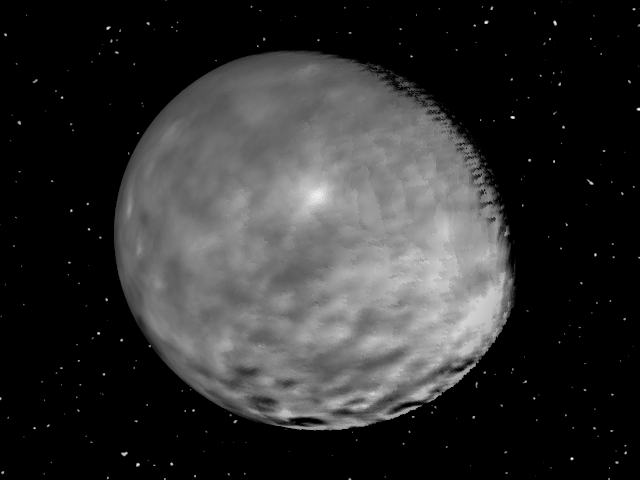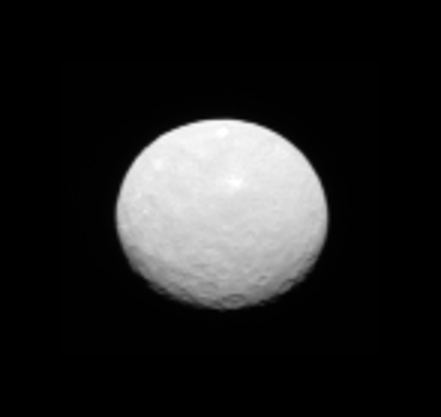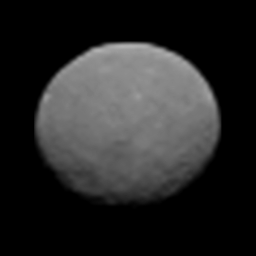It looks like you're using an Ad Blocker.
Please white-list or disable AboveTopSecret.com in your ad-blocking tool.
Thank you.
Some features of ATS will be disabled while you continue to use an ad-blocker.
share:
As it turns out, water in open space first boils and evaporates, then freezes into tiny grains. In any case, the conditions in space are not entirely
comparable to those on Ceres. The surface of this dwarf planet retains a certain amount of heat, which, it is believed, would drive sublimation of
any ice that happened to settle there, and presumably prevent its accumulation.
Besides this, is the fact that spectrographic surveys of the planet do not find evidence of any ice on the surface. These surveys have been sensitive enough to detect very small releases of water vapor from Ceres. It seems they should also be able to detect a thirty-mile-wide frozen lake there, if it existed. See the link below for an interesting article on this:
www.astrobio.net/news-exclusive/ice-on-ceres-an-interesting-paradox/
Besides this, is the fact that spectrographic surveys of the planet do not find evidence of any ice on the surface. These surveys have been sensitive enough to detect very small releases of water vapor from Ceres. It seems they should also be able to detect a thirty-mile-wide frozen lake there, if it existed. See the link below for an interesting article on this:
www.astrobio.net/news-exclusive/ice-on-ceres-an-interesting-paradox/
edit on 25-1-2015 by Ross 54 because: added comma
the white spot is really...
its a giant mediteranean woman in a toga carrying an armful of wheat.
its a giant mediteranean woman in a toga carrying an armful of wheat.
originally posted by: Ross 54
See the link below for an interesting article on this:
www.astrobio.net/news-exclusive/ice-on-ceres-an-interesting-paradox/
So Ceres is practically black (or very dark grey)? The Hubble images make it look fairly light-coloured, hence my assumption that it had a lot of ice on the surface.
I can see now from Wikipedia that Ceres is darker than the Moon (which has reflectivity of asphalt), with geometric albedo of 0.09.
Guys, today is the Day!
en.wikipedia.org...
Can't wait to see what the higher resolution pics have to show us. So far nothing in the news... I'm keeping my eyes open...
Images taken from Dawn of Ceres will exceed the resolution of the Hubble Space Telescope by January 26
en.wikipedia.org...
Can't wait to see what the higher resolution pics have to show us. So far nothing in the news... I'm keeping my eyes open...
originally posted by: swanne
Guys, today is the Day!
Images taken from Dawn of Ceres will exceed the resolution of the Hubble Space Telescope by January 26
en.wikipedia.org...
Can't wait to see what the higher resolution pics have to show us. So far nothing in the news... I'm keeping my eyes open...
When it gets there in April, it will first be orbiting at an altitude of 8,400 miles (13,500 km), which is close, but in subsequent months the orbit will take it even closer. In August, it will make a spiral dance down to an orbit of 920 miles (1480 km), and by November, Dawn will be orbiting at just 233 miles (375 km), which is closer than the ISS is to Earth. Those November images should be especially good.
Dawn will make its first full characterization of Ceres later in April, at an altitude of about 8,400 miles (13,500 kilometers) above the icy surface. Then, it will spiral down to an altitude of about 2,750 miles (4,430 kilometers), and obtain more science data in its survey science orbit. This phase will last for 22 days, and is designed to obtain a global view of Ceres with Dawn's framing camera, and global maps with the visible and infrared mapping spectrometer (VIR).
Dawn will then continue to spiral its way down to an altitude of about 920 miles (1,480 kilometers), and in August 2015 will begin a two-month phase known as the high-altitude mapping orbit. During this phase, the spacecraft will continue to acquire near-global maps with the VIR and framing camera at higher resolution than in the survey phase. The spacecraft will also image in "stereo" to resolve the surface in 3-D.
Then, after spiraling down for two months, Dawn will begin its closest orbit around Ceres in late November, at a distance of about 233 miles (375 kilometers). The dance at low-altitude mapping orbit will be a long waltz -- three months -- and is specifically designed to acquire data with Dawn's gamma ray and neutron detector (GRaND) and gravity investigation. GRaND will reveal the signatures of the elements on and near the surface...
Source: NASA's Dawn Fills out its Ceres Dance Card
a reply to: Soylent Green Is People
Too bad the vast majority of the images will be black&white (like it was with Vesta), and it would take some knowlegeable tinkering with the VIR to produce colour images.
Too bad the vast majority of the images will be black&white (like it was with Vesta), and it would take some knowlegeable tinkering with the VIR to produce colour images.
I can't believe no one has posted the new photo yet.
Click for Image
Aliens tudum-tsssss
Click for Image
However, scientists said the images have not yet revealed the nature of Ceres' mysterious white spot.
Aliens tudum-tsssss
There is also an animated series of the the latest images of Ceres, see link below. In the latest images, it looks to me as if the bright spot is
rather rectangular in shape. This might be due to the effect of pixelization, I suppose, but in the previous images, which were coarser, with even
more obvious pixel artifacts, the bright spot appeared vaguely oval in shape.
www.youtube.com...
www.youtube.com...
originally posted by: wildespace
a reply to: Soylent Green Is People
Too bad the vast majority of the images will be black&white (like it was with Vesta), and it would take some knowlegeable tinkering with the VIR to produce colour images.
I'm not an imaging expert (by no means), but I thought the camera had an 8-position filter wheel that would allow it to take images as viewed through those filters in wavelengths from 400 to 1050 nm, similar to the Mars Exploration Rovers (Spirit and Opportunity).
I realize the CDD on Dawn can see in grayscale only (although all CCDs are like that), but I assumed that the various filters would allow it to see images in the various wavelengths with differing intensities of grayscale, which would allow it to discern color from those grayscale intensities.
Maybe I'm wrong about Dawn's camera, but I thought that's how the imaging scientists back on Earth created "near true-color" images from Spirit and Opportunity's PanCams.
edit on 1/28/2015 by Soylent Green Is People because: (no reason given)
The bright patch might appear rectangular because of pixelization artifacts, and then again it may not. If this is the effect of pixelization, why didn't it show up in the previous series of images, which were even more obviously pixelated ? The bright spot was a blurry oval blob before, now with a closer look, it, and the terrain of Ceres appear somewhat clearer.
originally posted by: Soylent Green Is People
a reply to: Ross 54
Yeah, it might be due to pixel size, similar to the way the brighter edges of Ceres' northern hemisphere look "stepped" in that same animation.
a reply to: Ross 54
I don't know about comparing on image to the other, or what the spot looked like in other images. I'm simply pointing out that other parts of that particular image obviously had some pixel artifacts going on, such as (as I mentioned) the "sawtooth" or stepped edge of Ceres directly above the spot.
Considering that other parts of that particular image are stepped and blocky, I'm not sure we can concluded anything about the blockiness of the white spot.
I don't know about comparing on image to the other, or what the spot looked like in other images. I'm simply pointing out that other parts of that particular image obviously had some pixel artifacts going on, such as (as I mentioned) the "sawtooth" or stepped edge of Ceres directly above the spot.
Considering that other parts of that particular image are stepped and blocky, I'm not sure we can concluded anything about the blockiness of the white spot.
The next Ceres imaging session for Dawn is planned for next Tuesday, Feb. 3rd, only four days from now. It will present images of Ceres that are 70
pixels wide, giving a resolution figure of 8.5 miles per pixel.
This is about 63 percent better resolution than its current best images, and better than twice the resolution of the Hubble Space Telescope images, which for many years were the best available images of Ceres. At that time, Dawn will still be about 91,000 miles from Ceres.
This is about 63 percent better resolution than its current best images, and better than twice the resolution of the Hubble Space Telescope images, which for many years were the best available images of Ceres. At that time, Dawn will still be about 91,000 miles from Ceres.
The images of Ceres taken on Jan. 13th were released on the 19th, six days delay.
Those taken on Jan. 25 were presented on the 28th, three days delay.
Maybe they're getting better at this with time, and we'll be seeing new images tomorrow. The image files will be much larger than previous ones, though, and that could delay things.
Those taken on Jan. 25 were presented on the 28th, three days delay.
Maybe they're getting better at this with time, and we'll be seeing new images tomorrow. The image files will be much larger than previous ones, though, and that could delay things.
edit on 3-2-2015 by Ross 54 because: added word to improve composition.
twitter.com...
www.jpl.nasa.gov...
The new photos have arrived. From what I see there's more than one "white mysterious spot", thus no aliens Or... many, many aliens
www.jpl.nasa.gov...
The new photos have arrived. From what I see there's more than one "white mysterious spot", thus no aliens Or... many, many aliens
edit on 5-2-2015 by raikata because: (no reason given)
The bright spot still appears to be roughly 35 miles across, when measured, with a somewhat ragged, asymmetrical appearance. There appears to be a
much brighter, and much smaller bright spot within it, which couldn't have been resolved before. This bright spot still appears to be the most
conspicuous feature on the planet.
edit on 5-2-2015 by Ross 54 because: corrected diameter figure
originally posted by: Ross 54
The bright spot still appears to be roughly 40 miles across, when measured, with a somewhat ragged, asymmetrical appearance. There appears to be a much brighter, and much smaller bright spot within it, which couldn't have been resolved before. This bright spot still appears to be the most conspicuous feature on the planet.
I don't know if "ragged" is the right word to call it (yet). I'd say "irregular", but ragged seems to connote a jagged shape, and we just can't yet tell if it is jagged.
In the new animation they released (below), it may look ragged, but so does much of the rest of the planetoid - and that's due to the large size of the pixels, which, in turn, is probably due to image enlargement.
By the way, according to JPL/NASA, the animated GIF below was made by projecting still images onto a spherical shape, and then adding in a fake backdrop of stars.

Still frame of animation:

Are there any new images that show the large bright spot? I've seen a few new images (taken Feb. 4) that show some smaller bright spots, but I didn't see a new one of the larger bright spot. Was the above animation made using new images of the bright spot, or the same images we saw before (from Jan. 26)?
If there are new ones of the large bright spot, can someone please point me towards a link? Thanks!
Edit to add:
Is this series of still images below (strung together as an animation) from Feb. 4 show the large bright spot? I see a large bright spot in the middle of the frame at the beginning of the animation, but I can't tell if it the same large bright spot. It looks different here:

edit on 2/5/2015 by Box of Rain because: (no reason given)
new topics
-
A Warning to America: 25 Ways the US is Being Destroyed
New World Order: 11 minutes ago -
America's Greatest Ally
General Chit Chat: 56 minutes ago -
President BIDEN's FBI Raided Donald Trump's Florida Home for OBAMA-NORTH KOREA Documents.
Political Conspiracies: 5 hours ago -
Maestro Benedetto
Literature: 7 hours ago -
Is AI Better Than the Hollywood Elite?
Movies: 7 hours ago -
Las Vegas UFO Spotting Teen Traumatized by Demon Creature in Backyard
Aliens and UFOs: 11 hours ago -
2024 Pigeon Forge Rod Run - On the Strip (Video made for you)
Automotive Discussion: 11 hours ago
top topics
-
President BIDEN's FBI Raided Donald Trump's Florida Home for OBAMA-NORTH KOREA Documents.
Political Conspiracies: 5 hours ago, 26 flags -
Krystalnacht on today's most elite Universities?
Social Issues and Civil Unrest: 17 hours ago, 9 flags -
Gaza Terrorists Attack US Humanitarian Pier During Construction
Middle East Issues: 12 hours ago, 8 flags -
Supreme Court Oral Arguments 4.25.2024 - Are PRESIDENTS IMMUNE From Later Being Prosecuted.
Above Politics: 17 hours ago, 8 flags -
Weinstein's conviction overturned
Mainstream News: 15 hours ago, 8 flags -
Massachusetts Drag Queen Leads Young Kids in Free Palestine Chant
Social Issues and Civil Unrest: 14 hours ago, 7 flags -
Las Vegas UFO Spotting Teen Traumatized by Demon Creature in Backyard
Aliens and UFOs: 11 hours ago, 6 flags -
Meadows, Giuliani Among 11 Indicted in Arizona in Latest 2020 Election Subversion Case
Mainstream News: 14 hours ago, 5 flags -
2024 Pigeon Forge Rod Run - On the Strip (Video made for you)
Automotive Discussion: 11 hours ago, 4 flags -
Is AI Better Than the Hollywood Elite?
Movies: 7 hours ago, 3 flags
active topics
-
Massachusetts Drag Queen Leads Young Kids in Free Palestine Chant
Social Issues and Civil Unrest • 15 • : tarantulabite1 -
A Warning to America: 25 Ways the US is Being Destroyed
New World Order • 0 • : charlest2 -
America's Greatest Ally
General Chit Chat • 1 • : BingoMcGoof -
How ageing is" immune deficiency"
Medical Issues & Conspiracies • 35 • : annonentity -
HORRIBLE !! Russian Soldier Drinking Own Urine To Survive In Battle
World War Three • 49 • : Freeborn -
Gaza Terrorists Attack US Humanitarian Pier During Construction
Middle East Issues • 30 • : Asher47 -
Electrical tricks for saving money
Education and Media • 8 • : anned1 -
Is AI Better Than the Hollywood Elite?
Movies • 16 • : 5thHead -
Hate makes for strange bedfellows
US Political Madness • 48 • : Terpene -
President BIDEN's FBI Raided Donald Trump's Florida Home for OBAMA-NORTH KOREA Documents.
Political Conspiracies • 17 • : BingoMcGoof


